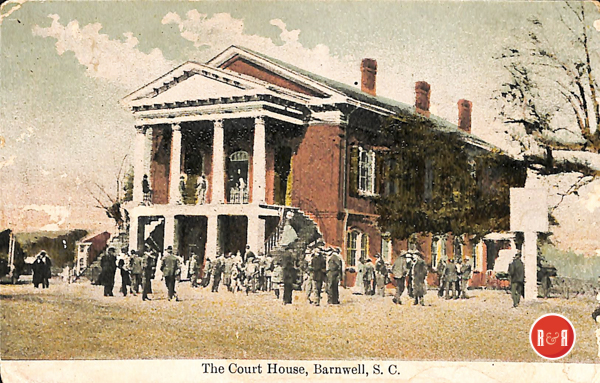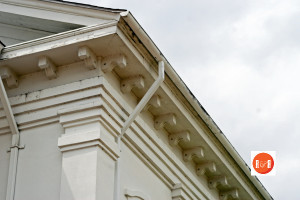141 Main Street
City Directories and History: Architect James Hagood Sams redesigned the building in 1923. Builders, J.H. Woodward and W.T. Blanton built it originally in 1879 and it was upgraded in 1902 by John Evan.
The Yorkville Enquirer of June 9, 1870 reported – “The offices for the sheriff, clerk of court, and judge of probate have been moved from Blackville to Barnwell in compliance with a judge’s order.”
The Yorkville Enquirer reported on June 20, 1878 – “Barnwell Co., is to have a new courthouse to be finished within a year.”

Early 20th century postcard view of the Courthouse. Courtesy of the AFLLC Collection – 2017
All early writings and accounts give no origin for the name Winton. General Richard Winn’s notes and a study of the political rivalry between him and the Barnwell brothers, John and Robert, make a better than circumstantial case for the county’s being named for the famous General Richard Winn of Winnsboro, and soon court was held there as it is now.
First, the state legislature named all counties. Unfortunately their debates were not recorded, and we do not know what hot and heavy words may have flowed prior to its naming. We do know that by 1785, at the naming of Winton County, Richard Winn, was at the height of his popularity. He had already been made a Brigadier General in the militia, serving well in the Revolution, was a member of the Jacksonborough Assembly in 1782, and while serving in “the senate” in 1786 was commissioned to purchase, survey and lay out the land to build a new state capital, Columbia, and further, to sell lots there. It is interesting to note that by February 11, 1785, Richard Winn had declined to serve as lieutenant- governor although elected. On March 12, 1785, the name Winton was given to the new county by the State Assembly. Charles Drayton became lieutenant- governor in Winn’s place, but did not qualify until March 22, 1785, due to an “indisposition.” It is equally fascinating to note that, although Barnwell District was the name officially given to the area in 1789, the Senate Journal continues to call it Winton until 1810. Between February 11 and March 12 we could well imagine that since the popular Winn had refused the second in command post in the state that the assembly named the new county, Winton, for him. 11 In 1800 Richard Winn was not only again elected lieutenant-governor but he served out his term until 1802. He was a member of the House of Representatives of the Third Congress of the United States in March, 1793, and returned to the Seventh Congress in January, 1803, remaining until the end of the Twelfth Congress in March, 1813, although he had moved to Maury County, Tennessee, where he took up lands in the fall of 1812…..
The Village of Barnwell – What became the village of Barnwell was about 1765 simply a small inn or tavern on the hill above Turkey Creek near White Oak Springs and was owned by a man named McHeath. “At that time the place was known as Red Hill, but when the Revolutionary War came on was called Barnwell Hill.” According to Captain Tarleton Brown of the Revolutionary Partisan Rangers in his memoirs, it was known as Red Hill during the Revolution and according to court records, it bore the name interchangeably with that of Barnwell from 1784 to 1798.Strangely enough, we see that at least some of the people of this area called the spot “Barnwell” long before the legislature did. The first record of the name appears in the court records in 1784 when land was bought from the Commissioners of Location of the District of Orangeburg. In Book one, Daniel Corbett’s deed reads “two hundred acres of land about two miles from Barnwell.” First the place was known as Red Hill and then as Barnwell Hill.
It is easy to see why it was first called Red Hill. The settlement lay on top of a steep hill of red clay. Only in recent years has the highway up Turkey Creek Hill, as Red Hill or Barnwell Hill in some-times called, been paved and the road bed cut down. Only one small portion of the red clay bank remains by the Baptist Cemetery, originally known as Red Hill Burying Ground.

Images courtesy of photographer Bill Segars – 2008



(Information from: Names in South Carolina by C.H. Neuffer, Published by the S.C. Dept. of English, USC)
Stay Connected
Explore history, houses, and stories across S.C. Your membership provides you with updates on regional topics, information on historic research, preservation, and monthly feature articles. But remember R&R wants to hear from you and assist in preserving your own family genealogy and memorabilia.
Visit the Southern Queries – Forum to receive assistance in answering questions, discuss genealogy, and enjoy exploring preservation topics with other members. Also listed are several history and genealogical researchers for hire.
User comments welcome — post at the bottom of this page.
n Roots and Recall. But remember each is private property. So view them from a distance or from a public area such as the sidewalk or public road.
Do you have information to share and preserve? Family, school, church, or other older photos and stories are welcome. Send them digitally through the “Share Your Story” link, so they too might be posted on Roots and Recall.
Thanks!

